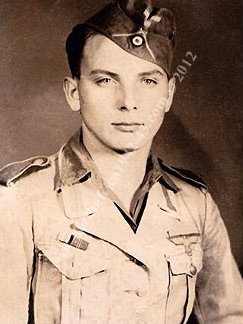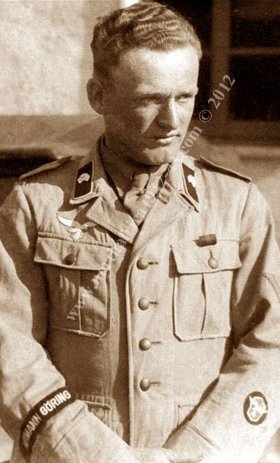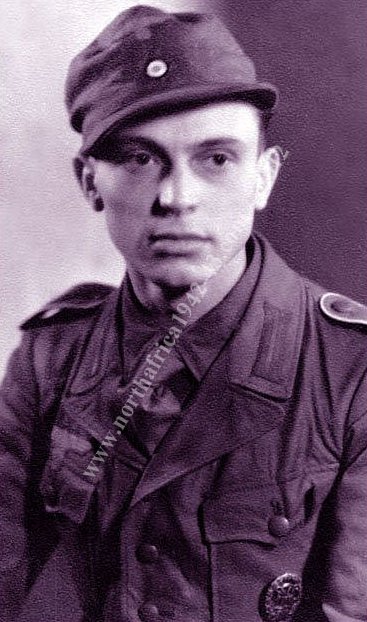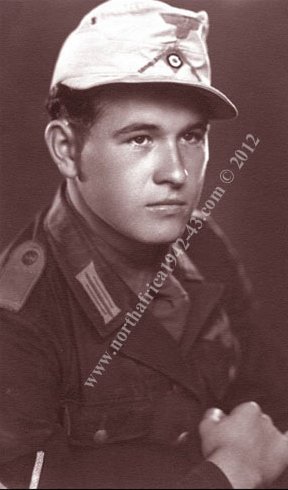








Afrika Korps VeteransIn 2009 I made contact with Afrika-Korps Historian Bernd Peitz. With the alarming number of vanishing Afrika-Korps veterans, Bernd was instrumental in directing me to surviving veteran, Rudolf Schneider in Dresden.The African Campaign - A Short Overview - By Bernd Peitz On
13 September 1940, an Italian Army group started an offensive from
their North African colony of Libya against the weak British border
security in their colony of Egypt. After taking about 100km of terrain,
the offensive ground to a halt on 18 September in the area of Sidi
Barrani. Heavily outnumbered, but with technically much better equipped
forces, the British started a counter offensive at the beginning of
December 1940, which turned into a fiasco for the Italians. After only
a week the British had driven them back out of Egypt and now chased the
fleeing Italians into Libyan territory. On 22 January, after taking
approximately 150 kilometers of terrain, they captured the fortress
and harbor of Tobruk. After overrunning a total of approximately 800km
of terrain along the Libyan coastline, and the conquest of additional
cities like Derna and Benghazi, the British offensive stalled due to
supply problems in the area around EI Agheila on 8 February 1941. In
trade for a few losses, they had taken around 130,000 Italian prisoners
-up to that time, and bagged large quantities of military equipment. In
desperation the Italian dictator Mussolini turned to his close [Axis]
alliance partner, the German dictator Adolf Hitler, and requested
military assistance from him. As an immediate stopgap, several German
Luftwaffe units were transferred to Sicily in order to disrupt the
British advance in Libya and to attack the British convoy escorts in
the Mediterranean. From 1 February 1941, the first German soldiers
arrived in Libya to support their hard-pressed Italian ally in the
battle against the British on land. In the belief that they were
serving their people here as well, they fought with exemplary courage
under the command of the legendary General Erwin Rommel. They were
usually inferior to the Allies in terms of equipment and personnel,
since for Hitler this was only a sideshow; the Eastern Front swallowed
up his divisions and war material. Of the little that was left to the
North African Theater the British sent a substantial portion to the
bottom of the Mediterranean. Nothing remained to Rommel but to employ
as much captured equipment as possible, and to make use of ruses to
fool the enemy about his actual strength. From the Italian side only a
few combat capable units - and those with outdated equipment - stood
available. After varying success they had nonetheless managed to push
the British and their allies back to Egypt and to within 100km of
Alexandria and the Nile Delta. Here the British had set up a final,
strong defensive line at the small place of EI Alamein, where the
German Afrika Korps was brought to a halt. A breakthrough of this line
was no longer possible with their degraded units; the German side had
hardly any operational Panzers remaining and this was the primary
weapon for such an offensive. A detour to the south around this
blockade line was not possible due to the adjacent Katana Depression
with its quicksand fields and salt marshes. While urgently needed
re-supply was awaited on the German side, which arrived only with
exceptional sparsity, the British under their new General Bernard
Montgomery concentrated their efforts on just this point and succeeded
in bringing in large quantities of materiel and fresh troops. In the
night of 23-24 October 1942 the British opened their counter offensive
against the German positions with a five-hour barrage from 1000 pieces
of artillery, to which little response could be made from the German
side as there was hardly any ammunition on hand. In a tough, ten-day
long struggle with the desperately defending Germans and Italians, the
vastly superior British, in the meantime, had managed to breakthrough
the Axis lines, taking 30,000 prisoners. Against Hitler's order to
stand fast, Rommel ordered a withdrawal back to defensive positions in
order to save the Afrika Korps from imminent destruction.The
situation intensified dramatically when only a few days later, on 7 and
8 November 1942, American troops landed in Morocco and Algeria. Rommel,
and finally the General Staff and Hitler as well, recognized the danger
of the complete loss of North Africa. While Rommel commanded the
orderly withdrawal to Tunisia in order to build a bridgehead there, a
large number of reserves were carried across to Tunisia in great haste
by the German leadership, in order to get there ahead of the Americans.
By the end of January 1943, German and Italian troops had withdrawn
completely into Tunisia. While the British probed carefully along the
Tunisian-Libyan border, the American advance in the Tunisian-Algerian
border zone was checked. Rommel wanted to lead his troops from there
back to Italy, but this was strictly refused by the German high
command. On the 9th of March Generalfeldmarschall Rommel, who was
totally exhausted physically, was relieved by Generaloberst' Von Arnim.
Bitter fighting flared again. On the German side, everything possible
was done to hold the Tunisian bridgehead, but this was fated to fail
from the beginning due to the immense personnel and material re-supply
of the Allies. Step by step, the bridgehead was squeezed ever tighter.
On the 12th and 13th of May 1943, the remainder of the German/Italian
Afrika Korps finally capitulated. Falling into Allied hands as POWs were
130,000 German and 120,000 Italian soldiers. The last of the Africa
fighters were only released after five years of captivity, in May of
1948.
 Rudolf Schneider Rudolf SchneiderI
was introduced to German veteran Rudolph Schneider by author/historian,
Bernd Peitz in the spring of 2010. At the time of my telephone
conversations with Rudolph, the most significant part of our discussion
was that fact that he actually fought against the Allies at El Guettar
in March of 1943. With each phone call, I learned more about
Rudolph. His unit was assigned as the personal combat team to Field
Marshall Erwin Rommel. Rudolph was a student of tropical botany, and
among other duties, was given the task of driver to Erwin Rommel. The
combat unit started out with some 380 men, only 40 returned to Germany
alive. I also learned from Bernd Peitz that many of the Afrika Korps
POW's who were imprisoned in Algeria, suffered ill treatment and
consequently died early deaths. In Sept. of 2010, I
traveled to Germany and interviewed Rudolph and 3 of his comrades.
Rudolph's memory was sharp and clear as he talked about Field
Marshall Rommel: "Whenever we took prisoners, we were all told to
share our water and food. Rommel fought with honor, and chivalry. He
had a mythological air about him; no matter how thick the air
would become with shrapnel, it seemed he was never harmed". Interview October 2010 in Dresden.
 Horst Galle Herr
Galle spoke no English. Translator Annekatrin Bach, (Rudolph's teacher
and friend), was instrumental in the entire process. Horst spoke about
his duties in North Africa with regard to the
reorganized motorized regiment re-designated Regiment (mot)
Hermann Göring, as Göring had been promoted to Reichsmarschall. In July
1942 the regiment was upgraded to brigade status and re-designated
Brigade Hermann Göring. In October 1942, while the brigade was still
being restructured, it was decided to further upgrade the status of the
Hermann Göring to a full division. The division would be organized
along the lines of a Herr Panzer division. Göring arranged for veteran
Herr panzer crewmen to be transferred to his division, and brought the
mechanized infantry component up to strength with the addition of the
other units. Herr Galle continued in detail about his specific
mechanical duties the with Panzer division, and the difficulties faced by Erwin
Rommel's Afrika Korps as they retreated from the Egyptian-Libyan
border back towards Tunisia. Interview October 2010 in Dresden.  Rudolf Nickol Herr
Nickol was brought to our little hotel discussion group in Dresden by
Rudolph Schneider. Rudolf carried a sad memory regarding his
unit's retreat; They were unfortunately over-run at Gabes. The
10th Panzer was tasked with pushing the Allies back into the interior,
and the two forces met at the Battle of El Guettar on March 23rd 1943. At first
the battle went much as it had in earlier matchups, with the German
tanks rolling up lead units of the US forces. However, they soon ran
into a U.S. minefield, and immediately the U.S. artillery and anti-tank
units opened up on them. The 10th lost 30 tanks over a short period,
and retreated out of the minefield. A second attack formed up in the
late afternoon, this time supported by infantry, but this attack was
also beaten off and the 10th returned to Gabčs. It
was during this time that Rudolph Nickol's unit was
nearly annihilated. He was overcome with grief as he
recalled stepping over many of his dead comrades: "There were dead
to my left and to my right. I had to cautiously crawl over them in
order not to be detected." Interview October 2010 in Dresden.  Heinz Wünsche Herr Wünsche was articulate and carefully deliberated his comments in response to my questions through Annekatrin Bach. His most interesting story was about Field Marshall Rommel during a rushed march: "There was a terrible traffic jam as we were trying to get by other vehicles and machinery. The road was totally blocked. In the distance I heard the roar of an oncoming engine. Moments later, I could see Rommel standing up in his lorry, shouting: "Get these machines moving!" "rasch machen - inf es muss rasch gehen". The other particularly touching story, was when Heinz got wounded. "I was severely wounded in North Africa and basically left for dead. My arm was shot to pieces, almost a useless limb." For the Afrika Korps, it was the beginning of the end. Heinz's injuries to his left arm were clearly visible the day of our interview. The next day during my stay in Dresden, I was treated to a personal tour of Frauenkirche by his gracious wife. In 1945 allied forces targeted Dresden. Frauenkirche withstood two days and nights of bombardment until sandstone pillars supporting the large dome succumbed to the heat generated by some 650,000 incendiary bombs that were dropped on the city. Interview October 2010 in Dresden. Photos and memorabilia provided by the veterans and their families. This independent documentary is not intended to be a comprehensive account of the war in North Africa 1942-43. The completed film will feature rare interviews from veterans connected to the story. The search to locate veterans within this time frame was very difficult. With no funding and a small film crew who sporadically assisted with re-creations, the bulk of production falls upon one individual. Contributions of any kind are welcomed. northafricaww2survivors@gmail.com Photos, illustrations, art work or interviews may not be reproduced, copied, stored, manipulated or redistributed without the expressed permission of the author. Michael Fraticelli - North Africa 1942-43 Survivors' Stories © 2015 |
